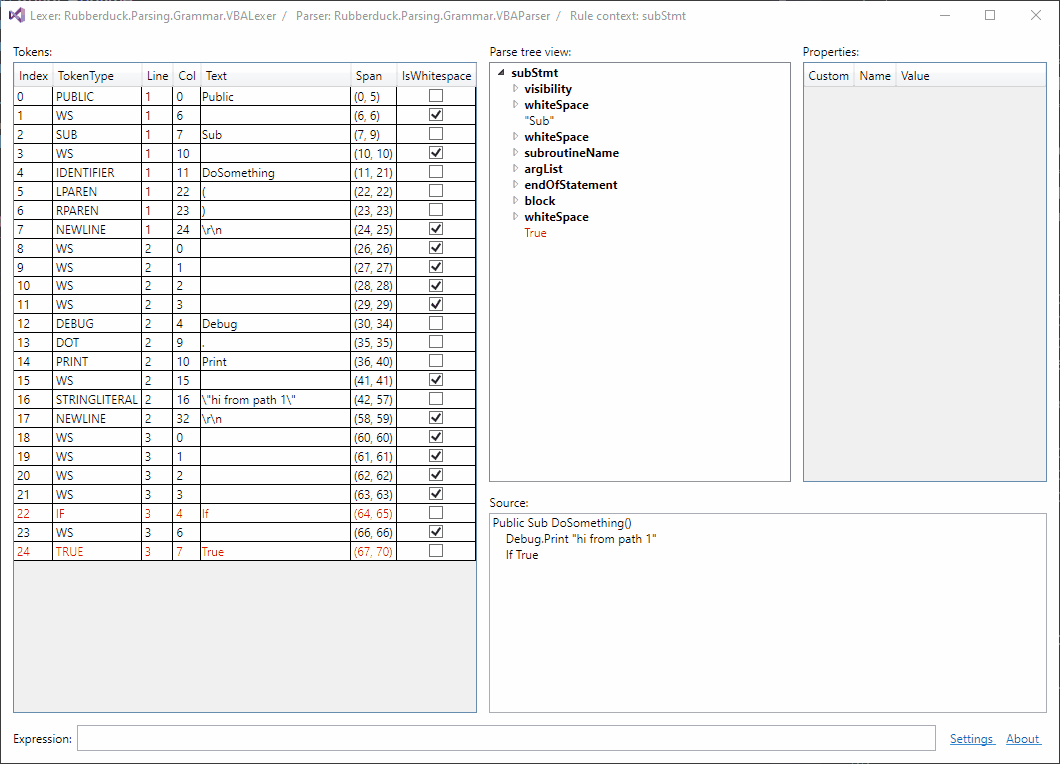-
List of tokens (error tokens are highlighted in red)
-
Treeview of rule contexts and terminal nodes (error nodes in red)
-
Properties of selected treeview node (properties not declared in the Antlr namespace are checked)
-
Input text, or the text from the current channel positioned as in the input
-
Selection sync, when selecting in the token list, the tree view, or the source text.
-
Filtering the token list, by text, whitespace, or error; or by specific token types:
-
Filtering the parse tree nodes by text, whitespace, or error nodes; or by specific rule types.
-
Set a specific node as the root node, either in the current window, or in a new window
-
You can also embed the same UI in your own applications.
- Tested with Visual Studio 2019 or 2017 (may work with older versions as well)
- Supports the current Antlr.Runtime.Standard.DLL (4.7.2) as well as the older Antlr.Runtime.DLL (4.6.6).
Before installing, you need to determine two things:
- There are two .NET variants of the ANTLR4 runtime library: the "standard" version -- Antlr4.Runtime.Standard -- and the "legacy" Antlr4.Runtime at version 4.6.6. Which variant is your code using?
- Are you using Visual Studio 2019 or 2017?
Then:
-
Go to the releases page. Choose the appropriate ZIP file(s) based on the Antlr4 variant and your version of Visual Studio.
For example, if you're in Visual Studio 2019 and debugging code written against
Antlr4.Runtime.Standard, download theParseTreeVisualizer.Standard.2019.zipfile.Note: if you need to, you can download and install all four visualizer variants; they won't overwrite each other.
-
You may need to unblock the file.
-
Unzip the contents of the ZIP file into one of Visual Studio's recognized visualizer folders:
- VisualStudioInstallPath
\Common7\Packages\Debugger\Visualizers My Documents\Visual StudioVersion\Visualizers
You don't have to restart VS, just make sure VS is not currently in a debugging session
- VisualStudioInstallPath
You can also compile the source yourself (ANTLR4ParseTreeVisualizer.sln) and place the output DLLs in one of the appropriate visualizer folders.
For VS 2017, the DLLs will end up in either the Visualizers parent folder, or a single subfolder. For VS 2019, there are additional subfolders for debugging various target frameworks.
- Begin a debugging session, and break at some point.
- Hover over an instance of one of the visualizer target types (
Antlr4.Runtime.RuleContext,Antlr4.Runtime.BufferedTokenStream, orstring), in the code editor, or the Watch or Locals window. This instance can be exposed by any variable, or any expression; the type of the expression doesn't matter. - Click on the magnifying glass to the right of the expression.
- You may need to choose a lexer class if you are visualizing a
stringand there are multiple lexers in the debugged assemblies. - You may need to choose a parser class and a parser method from the settings, if you are visualizing a
BufferedTokenStreamor astring, and the debugged assemblies have multiple parser classes.
Note that these choices -- selected lexer, parser and parser method -- persist between sessions, so if you've already chosen, there's no need to do so again.
- You may need to unblock the ZIP file.
- If you see an error message "Could not load this custom viewer", try turning Managed Compatibility off (Tools -> Options... -> General -> Debugging).
- Test the visualizer. (The significance of this kind of contribution cannot be overestimated.)
- Suggest ideas and enhancements (issues)
- Notify about bugs (issues)
- Provide screenshots which could be used to demonstrate different features of the visualizer (also via (issues))
- Star the project
- Spread the word
- Provide feedback to Microsoft about these limitations to the visualizer API







